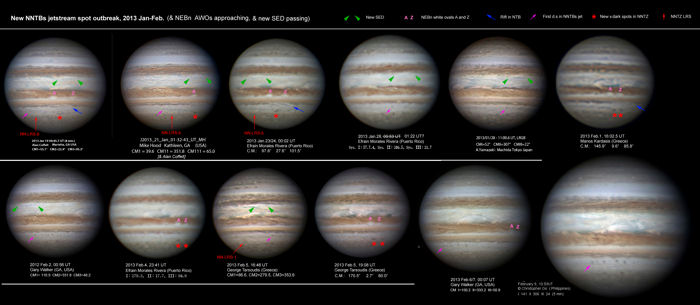|
Current news on Jupiter: NNTBs jet-stream activity resumes, NEBn ovals interact, new SED is established. Febuary 10, 2013
|
|
Japanese (translated by Yuichi Iga)
Hello all, The attached set of images shows three notable developments on Jupiter, which all deserve close attention in the next week or two. 1) NNTBs jet-stream activity resumes: Since the NTB upheaval started last April, the whole N.N.Temp. domain has been virtually white and the usual NNTBs jet-stream spots have been absent. On Feb.7, Gary Walker took a fine image on which Manos Kardasis pointed out: “NNTB dark spots have shown up. Is it a sign that will lead to a NNTB darkening?”
Indeed, there is a chain of at least 6 tiny dark spots moving with the NNTBs jet-stream. The leading spot has DL2 = -89 deg/month, typical of this jet-stream. A few tiny dark spots in the NNTBs latitude are also visible at other longitudes. 2) NEBn ovals interact: Observers have been keenly watching the two great white ovals on the NEBn, white spot A and white spot Z, as they approached each other. Now, they have begun to interact, as WSZ is more northerly than WSA. As with the encounter between WSA and WSB last Nov., and other such encounters in previous years [see our Report no.9, Appendix 2], the two ovals are expected to swing round each other and partially merge but to release a small slower-moving remnant as well. It would be informative to observe such a merger at even higher resolution and observers have the chance to do this now as WSA and WSZ are exceptionally large bright ovals. 3) A new SED is established: Last autumn I suspected that a new S. Equatorial Disturbance (SED) was developing, and at the New Year it seemed to be forming more distinctly, just after passing the GRS on Dec.27/28 [see our Report no.9, Appendix 4]. Indeed, it has remained a distinct feature with the familiar form of a SED since then, and will soon complete its first circuit of the planet as such, due to pass the GRS again around Feb.18. It is indicated in the attached set of images, and we expect to post a compilation soon showing its complete circuit of the planet. Congratulations to all observers, and best wishes for good observing conditions in the coming days and weeks. John
|
|
Figures
 Click for the original size
 Click for the original size
|
|
_______________________________ John H. Rogers, Ph.D. Jupiter Section Director, British Astronomical Association jhr11@cam.ac.uk http://www.britastro.org/jupiter/ _________________________________
|
|
木星最新ニュース NNTBsジェット気流活動の再開、NEBn白斑の相互作用、新しいSEDの確立
Current news on Jupiter: Febuary 10, 2013
|
|
図
 Click for the original size
 Click for the original size
|
|
_______________________________ John H. Rogers, Ph.D. Jupiter Section Director, British Astronomical Association jhr11@cam.ac.uk http://www.britastro.org/jupiter/ _________________________________
|
|
【日本語訳:伊賀祐一 (Yuichi Iga)】 |